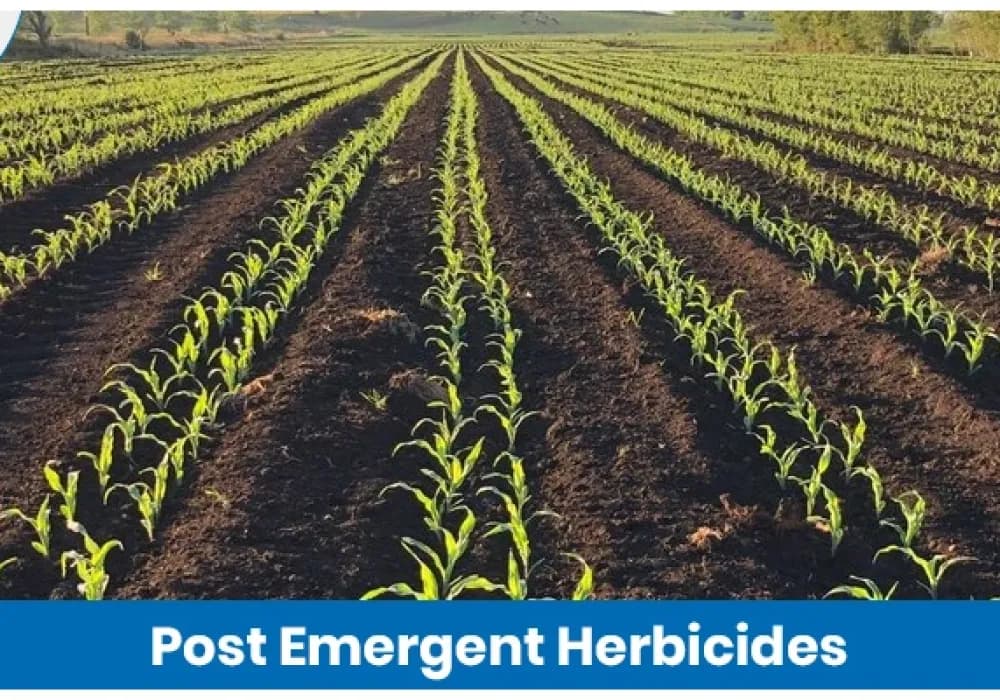Sometimes weeds can be extremely irritating and problematic, especially when growing high-quality crops. Weeds take up space, sunlight, water, and nutrition from the soil that are meant for our crop. If not treated in time, they eventually affect the quality of the crop and the overall yield. If your crops are already struggling against harmful weeds and unwanted grass, then it's time to use post-emergent herbicides.
Here is your ultimate guide on what post-emergent herbicides are, their examples, and how to use them so effectively that you can grow high-quality crops every season, without worrying about crop loss.
What are Post-Emergent Herbicides?
As the name suggests, they are used after the weeds have emerged and are visible above the soil surface. The pre-emergent type is mixed into the soil and applied before weeds can germinate, reducing crop damage.
Effective weed control is not just about applying chemicals, it actually requires an understanding of how herbicides work, taking the correct precautions, and knowing exactly where to use them. You can make smarter and profitable decisions by developing this understanding and knowing the examples of post-emergent herbicides while also protecting your crop and the soil.
We will cover all of these topics in this blog, along with some examples of post-emergent herbicides. So, let’s first understand how post-emergent herbicides control weeds in fields.
How Post-Emergent Herbicides Work to Control Weeds?
Think post-emergent herbicides are like soldiers that follow your direct orders. They target the already emerged weeds by attacking them internally and externally. There are two main modes of action through which these herbicides can affect the targeted weed plants. They are systemic action (internal) and contact action (external).
“In systemic action, the herbicide works from inside the plant. The plant will absorb this chemical through its leaves and distribute it throughout the plant tissues. Systemic action is particularly effective against perennial weeds with dense bodies and thick roots.
On the other hand, in contact action, the effects can be seen precisely where the herbicide comes into contact with the crops, which is why they are called contact herbicides. These types of herbicides are quick-acting, allowing for immediate results and effective control of annual weeds.”
They are best used in paddy fields in order to kill grassy weeds that grow between the rows of the commercial crop. They are also used in soybean and groundnut crops to control the broadleaf weeds.
Most Common Examples of Post-Emergent Herbicides in Agriculture
Selective herbicides are crop-friendly due to their ability to filter the effect and limit it to the weeds. The selective type targets specific weeds and leaves the commercial crop unharmed. These are particularly helpful in maize production.
For the non-selective type of herbicides, there is no filter or limit to their effects. They kill off every and all green plants that they come in contact with, whether commercial crop or weeds. They are used to clear a field or land preparation before the sowing phase.
Post Emergent Herbicide Examples
The broadleaf weed controllers and grass weed controllers are the specific types of post-emergent herbicides that work for very specific weed plants. Cereal crops, such as wheat and rice, benefit greatly from broadleaf controllers where there is a dominance of broadleaf weeds. Similarly, pulses and vegetable production is saved from grass weeds by applying grass weed controllers.
Glyphosate:
Glyphosate is a non-selective systemic type of herbicide that is widely used for clearing fields. It penetrates the plant tissues and kills the plant from within. It is exceptionally effective on perennial weeds.
2,4-D:
Another post-emergent herbicide is 2,4-D, a selective herbicide that is effective against broadleaf weeds, while sparing grasses. Its application has been widely adopted in cereal cultivation, like wheat, maize, and rice.
Dicamba:
If there are resistant broadleaf weeds among maize and soybean crops, dicamba comes to the rescue and deals with rigid broadleafs. Majorly effective on rigid weeds like pigweed, experienced farmers use dicamba to eradicate herbicide-resistant weeds.
Fluazifop:
Designed to target grassy weeds, fluazifop eradicates weeds in soybean, vegetable crop and groundnut crop. It affects the weed plant by interfering with the inner fatty acid synthesis in grass weeds. It is used to flourish commercial broadleaf crops and curb the grassy competition.
Imazethapyr:
Considering all the post-emergent herbicide examples, imazethapyr is extremely popular among all. It works on both grassy and broadleaf weeds and is effective for pulses like groundnuts and soybeans.
Fenoxaprop-p-ethyl:
This one’s used in rice fields to deal with grassy weeds like wild oats and barnyard grass, which compete with paddy. It is used in the early growth stages to specifically save the profitable grasses.
You can confidently match problems related to weeds with appropriate solutions by learning how to recognise the types of herbicides, as opposed to blindly applying any random herbicides.
Practical Usage of Herbicides Across Crops and Seasons
Post-emergent herbicides play an extremely vital role in many Indian crops during the farming season. You can systematically plan your weed management strategy by understanding the best uses of herbicides. To understand their usage, you can divide them into two groups; seasonal uses and crop-specific uses.
Seasonal Uses:
- Kharif (Monsoon): High moisture levels support plant growth, allowing weeds to grow aggressively. Paddy, Soybean, and Maize require post-emergent herbicides at around 15 to 20 days after the sowing phase.
- Rabi (Winter): Wheat and Mustard production thrives magically. But along with them, even the broadleaf weeds grow rapidly, which are then controlled by selective herbicides.
- Summer: Vegetable crops like Okra, Brinjals, and tomatoes require spot applications due to the rapid dominance of grassy weeds.
Crop-specific Uses:
Grass and sedge weeds cause problems for Rice or Paddy cultivation. Wheat and Maize are the cereal crops that need protection from broadleaf weeds that germinate completely with the commercial crop. And lastly, both grass weeds and broadleaf weeds collectively grow together in cotton and soybean production.
All of these require targeted post-emergent herbicides that serve as an alternative to manual weeding and hand-picking.
Best Practice For Safe and Effective Application
Correct herbicide application is as vital as making the correct herbicide choice. You may also have questions on how to apply herbicides in the field for better results. Below are some tried and tested methods that may yield excellent results.
Timing:
The time of application is everything. Spraying when the weeds are young and actively growing is a strong strategy. That's because older weeds can be particularly challenging to manage.
Correct Equipment:
Select your preferred sprayer based on the size of your cultivation area. Knapsack sprayers are suitable for small fields. Whereas larger fields may require power sprayers and tractor-mounted ones.
Weather Conditions:
Spraying before rain or during strong winds can reduce the herbicides’ effectiveness and also harm the commercial and surrounding crops. Spray when the conditions are favourable.
Dosage:
While underuse can cause weed regrowth, overuse can entirely damage your yield. Measuring and following the guidelines when mixing herbicides is always a smarter approach.
Protective Gear:
Always use gloves, masks, and proper protective clothing while spraying. These are chemicals after all, and they can cause damage to human skin, eyes, respiratory system, and other body parts. Always cover your head and face, and do not leave your skin exposed while spraying.
FAQs

K SANJEEVA REDDY
CHIEF AGRONOMY OFFICER
Sanjeeva Reddy K. serves as the Chief Agronomy Officer at AGRIBEGRI TRADELINK PVT LTD, a role he stepped into in July 2025, where he oversees and manages agronomy expertise across the organization. He holds a Postgraduate degree in Agricultural Science from Tamil Nadu Agricultural University, India, and is a Certified Crop Advisor accredited by the Indian Society of Agri Professionals, in association with the American Society of Agri Professionals. With more than 20 years of experience in crop production, Reddy has built extensive expertise working across reputed agribusiness industries. A significant part of his career includes a decade-long tenure with the internationally recognized Indian brand MULTIPLEX, a leading Bangalore-based manufacturer and marketer of plant nutrients, where he played a key role in driving growth and innovation.
